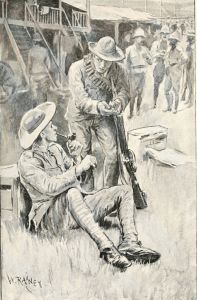

YORKE MEETS AN OLD FRIEND.
WITH ROBERTS TO PRETORIA
A TALE OF
THE SOUTH AFRICAN WAR
BY
G.A. HENTY
Author of "With Buller in Natal" "In the Irish Brigade" "For Nameand Fame" "With Cochrane the Dauntless" &c.
WITH TWELVE ILLUSTRATIONS BY WILLIAM RAINEY, R.I.
AND A MAP
NEW YORK
CHARLES SCRIBNER'S SONS
1901
Copyright, 1901,
BY
CHARLES SCRIBNER'S SONS
Published September, 1901
THE CAXTON PRESS
NEW YORK
PREFACE
The war in South Africa may be roughly divided into three parts. First,The desperate fighting in Natal, which culminated in the relief ofLadysmith. Second, The advance towards Kimberley begun by Lord Methuenbut arrested at Magersfontein, and renewed with a vastly greater forceby Lord Roberts and pushed forward to Pretoria, involving the reliefof Kimberley and the capture of Cronje at Paardeberg, but unmarked byany resistance comparable with that experienced by Buller. Third, Theadvance to Komati Poort, the breaking down of all organized opposition,and the degeneration of the war into isolated efforts by guerilla bandscapable of annoyance but powerless to affect the issue. The first ofthese chapters was told last year in With Buller in Natal.
The second phase of the struggle did not afford such examplesof warfare on a large scale as might have been anticipated. Theoperations of Lord Methuen for the relief of Kimberley were broughtto a stand-still by the inadequacy of the comparatively small forceunder his command for the task of breaking down the opposition of theBoer army, holding, like that before Ladysmith, a position of immensenatural strength. With the advance, however, of the army under GeneralRoberts, resistance on a large scale virtually collapsed.
It might have been supposed that the Boers would resist the advanceupon their capital as sturdily as they had opposed the relief ofLadysmith, and that at least they would fight one great battle,supported by the forts with which they had surrounded Pretoria. Itturned out otherwise. Although brave and tenacious when fighting underthe cover of rocks, the Boers had not the heart to venture even onceto face the British in the open, and were turned out of one afteranother of their carefully-prepared positions without making anydetermined stand. After Cronje's force had been captured at Paardeberg,and the force that had advanced to his assistance driven off the roadto Bloemfontein, no serious opposition was offered to the advance toPretoria.
The third phase was marked at first by many exciting incidents, butby no great battle. The Boers defended some of the positions takenup by them with bravery and determination, but when once the railwayto Komati Poort had fallen into our hands the war degenerated into aguerilla struggle. It was a war of raids, sometimes by a comparativelystrong force and at others by handfuls of plunderers; a war trying andfatiguing in the extreme, and demanding extraordinary endurance onthe part of our troops, but of which the end was always in sight. Theobstinacy of the Boers had only the effect o